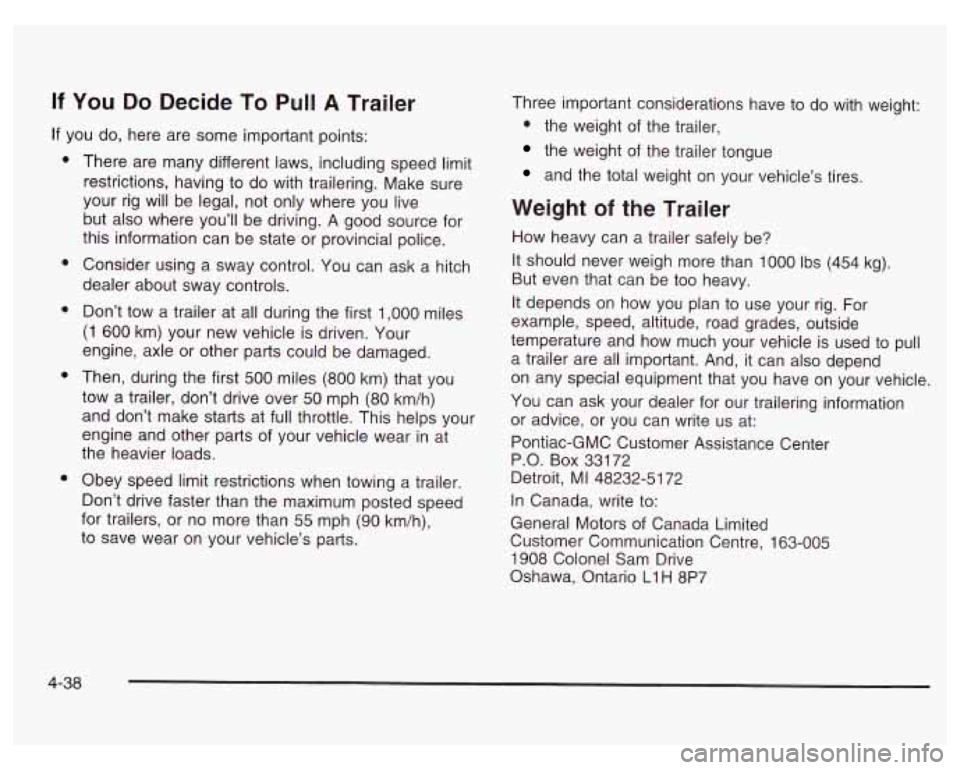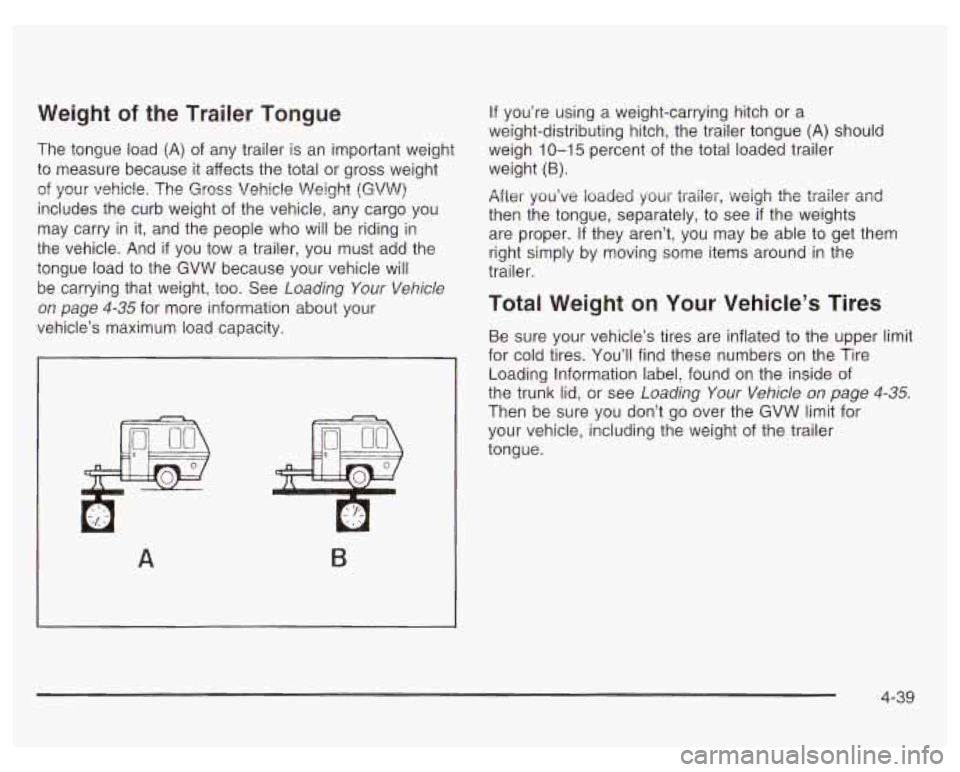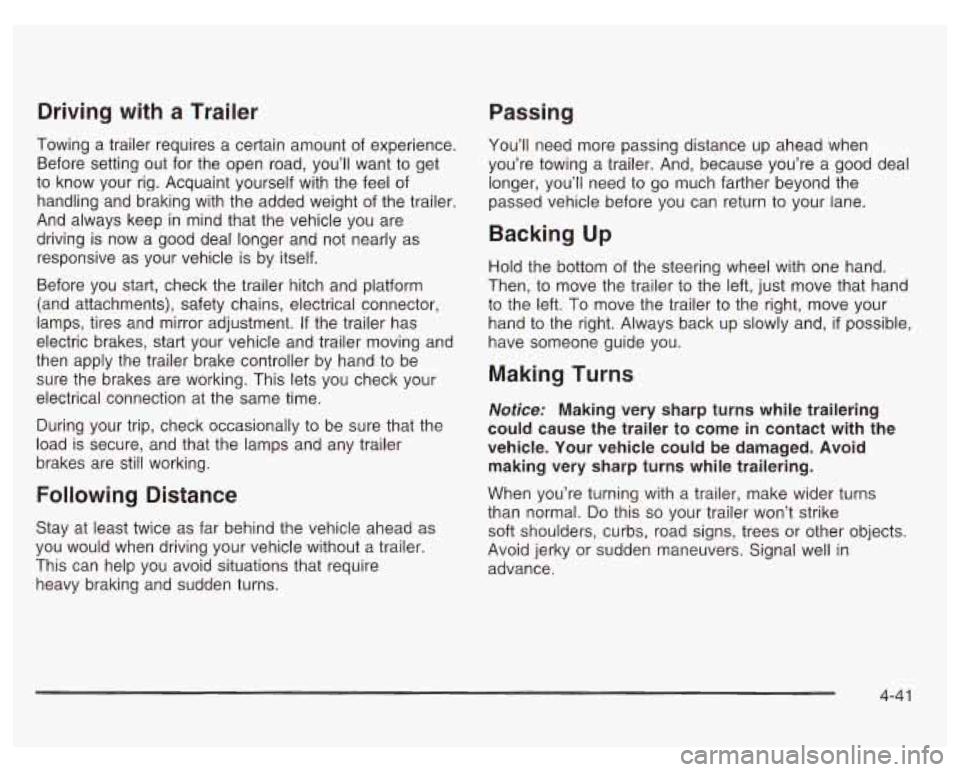2003 PONTIAC GRAND PRIX weight
[x] Cancel search: weightPage 219 of 378

If You Do Decide To Pull A Trailer
If you do, here are some important points:
e
e
e
e
There are many different laws, including speed limit
restrictions, having to do with trailering. Make sure
your rig will be legal, not only where you live
but also where you’ll be driving. A good source for
this information can be state or provincial police.
Consider using a sway control. You can ask a hitch
dealer about sway controls.
Don’t tow a trailer at all during the first
1,000 miles
(1 600 km) your new vehicle is driven. Your
engine, axle or other parts could be damaged.
Then, during the first
500 miles (800 km) that you
tow
a trailer, don’t drive over 50 mph (80 km/h)
and don’t make starts at full throttle. This helps your
engine and other parts of your vehicle wear in at
the heavier loads.
Obey speed limit restrictions when towing a trailer.
Don’t drive faster than the maximum posted speed
for trailers, or no more than 55 mph
(90 km/h),
to save wear on your vehicle’s parts. Three
important considerations have to do with weight:
e the weight of the trailer,
the weight of the trailer tongue
and the total weight on your vehicle’s tires.
Weight of the Trailer
How heavy can a trailer safely be?
It should never weigh more than
1000 Ibs (454 kg).
But even that can be too heavy.
It depends on how you plan to use your rig. For
example, speed, altitude, road grades, outside
temperature and how much your vehicle is used to pull
a trailer are all important. And, it can also depend
on any special equipment that you have on your vehicle.
You can ask your dealer for our trailering information
or advice, or you can write us at:
Pontiac-GMC Customer Assistance Center
P.O. Box 33172
Detroit, MI 48232-51 72
In Canada, write to:
General Motors of Canada Limited
Customer Communication Centre,
163-005
1908 Colonel Sam Drive
Oshawa, Ontario
L1 H 8P7
4-38
Page 220 of 378

Weight of the Trailer Tongue
The tongue load (A) of any trailer is an important weight
to measure because it affects the total or gross weight
of your vehicle. The Gross Vehicle Weight (GWV)
includes the curb weight of the vehicle, any cargo you
may carry in it, and the people who will be riding in
the vehicle. And
if you tow a trailer, you must add the
tongue load to the GVW because your vehicle will
be carrying that weight, too. See Loading Your Vehicle
on page 4-35 for more information about your
vehicle’s maximum load capacity.
A
If you’re using a weight-carrying hitch or a
weight-distributing hitch, the trailer tongue
(A) should
weigh
10-15 percent of the total loaded trailer
weight
(B).
After you’ve loaded your trailer, weigh the trailer and
then the tongue, separately, to see if the weights
are proper.
If they aren’t, you may be able to get them
right simply by moving some items around in the
trailer.
Total Weight on Your Vehicle’s Tires
Be sure your vehicle’s tires are inflated to the upper limit
for cold tires. You’ll find these numbers on the Tire
Loading Information label, found on the inside of
the trunk lid,
or see Loading Your Vehicle on page 4-35.
Then be sure you don’t go over the GVW limit for
your vehicle, including the weight of the trailer
tongue.
4-39
Page 222 of 378

Driving with a Trailer
Passing
Towing a trailer requires a certain amount of experience.
Before setting out for the open road, you’ll want to get
to know your rig. Acquaint yourself with the feel
of
handling and braking with the added weight of the trailer.
And always keep in mind that the vehicle you are
driving is now a good deal longer and not nearly as
responsive as your vehicle is by itself.
Before you start, check the trailer hitch and platform
(and attachments), safety chains, electrical connector,
lamps, tires and mirror adjustment.
If the trailer has
electric brakes, start your vehicle and trailer moving and
then apply the trailer brake controller by hand to be
sure the brakes are working. This lets you check your
electrical connection at the same time.
During your trip, check occasionally to be sure that the
load is secure, and that the lamps and any trailer
brakes are still working.
Following Distance
Stay at least twice as far behind the vehicle ahead as
you would when driving your vehicle without a trailer.
This can help you avoid situations that require
heavy braking and sudden turns. You’ll need more
passing distance up ahead when
you’re towing
a trailer. And, because you’re a good deal
longer, you’ll need to go much farther beyond the
passed vehicle before you can return to your lane.
Backing Up
Hold the bottom of the steering wheel with one hand.
Then, to move the trailer to the left, just move that hand
to the left. To move the trailer to the right, move your
hand to the right. Always back up slowly and,
if possible,
have someone guide you.
Making Turns
Notice: Making very sharp turns while trailering
could cause the trailer
to come in contact with the
vehicle. Your vehicle could be damaged. Avoid
making very sharp turns while trailering.
When you’re turning with a trailer, make wider turns
than normal. Do this
so your trailer won’t strike
soft shoulders, curbs, road signs, trees or other objects.
Avoid jerky or sudden maneuvers. Signal well in
advance.
4-4 1
Page 373 of 378

To Use the Engine Coolant Heater .................... 2-23
Top
of the Instrument Panel ............................. 5-90
Top Strap
...................................................... 1-39
Top Strap Anchor Location
............................... 1-40
Torque Lock
................................................... 2-29
Total Weight on Your Vehicle’s Tires
.................. 4-39
Towing
Recreational Vehicle
..................................... 4-33
Towing a Trailer
.......................................... 4-37
Your Vehicle
............................................... 4-33
Control System (TCS)
.................................. 4-10
Traction
Control System Warning Light
....................... 3-29
Enhanced Traction System (ETS)
................... 4-1 1
Warning Light .......................................... 3-30
Enhanced
Traction System (ETS)
Low Light
................................................... 3-30
Trailer Brakes
................................................. 4-40
Transaxle Fluid, Automatic
....................................... 5-27
Transaxle Operation, Automatic
......................... 2-24
Transmission, Transaxle, Transfer Case Unit
Transportation Options
...................................... 7-7
Trip Computer
................................................ 3-40
Control Buttons
........................................... 3-42
Functions
.................... ............ 3-42
Trip Odometer
.......... ............ 3-25
Repair
Manual
............................................ 7-10 Trunk
........................... ................. 2-11
Trunk Access Panel
..., .... ............. 2-41
Trunk Lock
................................................ 2-11
Turn SignaVMultifunction Lever
........................... 3-5
Turn Signals When Towing a Trailer
.................. 4-42
Turn
and Lane-Change Signals
............... ... 3-5
Underbody Flushing Service
............................. 6-12
Underhood Fuse Block
................................... 5-100
Understanding Radio Reception ........................ 3-57
Uniform Tire Quality Grading
............................ 5-72
United States
................................................... 7-4
Unlocking the Theft-Deterrent Feature
After a Power Loss
...................................... 3-55
Used Replacement Wheels
.............................. 5-74
Using Cleaner on Fabric
.................................. 5-89
Variable Effort Steering
.................................... 4-13
Vehicle Control
........................................................ 4-6
Damage Warnings
........................................... iv
Loading
...................................................... 4-35
Symbols
......................................................... iv
14
Page 374 of 378

Vehicle Identification
Number (VIN)
............................................. 5-96
Service Parts Identification Label
................... 5-96
Vehicle Personalization .................................... 2-43
Arming and Disarming the Content
Theft-Deterrent System
............................. 2-52
Automatic Door Locks
.................................. 2-45
Content Theft-Deterrent System
..................... 2-51
Delayed Illumination and Exit Lighting
............. 2-44
Entering Programming Mode
......................... 2-44
Exiting Programming Mode
........................... 2-53
Last Door Closed Locking and Lockout
Protection
............................................... 2-47
Remote Driver Unlock Control
....................... 2-48
Remote Lock and Unlock Confirmation
........... 2-49
Vehicle Storage
.............................................. 5-53
Ventilation Adjustment
...................................... 3-22
Vinyl
............................................................. 5-90
Visor Vanity Mirror
.......................................... 2-14
Visors
.............................. .............. 2-14
Warning Lights. Gages and Indicators
................ 3-23
Hazard Warning Flashers
............................... 3-3
Other Warning Devices
.................................. 3-4
Warnings Warnings
(cont.)
...
Safety and Symbols ......................................... III
Vehicle Damage .............................................. iv
Washing Your Vehicle
...................................... 5-91
Weatherstrip Lubrication ................................... 6-10
Weight of the Trailer
........................................ 4-38
Weight of the Trailer Tongue
............................. 4-39
What Kind of Engine
Oil to Use ........................ 5-20
What Kind of
Oil to Use .................................. 5-24
What to Do with Used Oil
................................ 5-24
What to Use
.................................. 5-30, 5-47, 5-48
Wheels Alignment and Tire Balance
.......................... 5-73
When to Add Engine Oil
.................................. 5-19
When to Change Engine Oil
(GM Oil Life SystemTM) ................................ 5-23
When to Check
...................................... 5-24, 5-69
When to Check and Change
............................ 5-27
When to Check Power Steering Fluid
................ 5-47
When You Are Ready to Leave After
Parking on a Hill
......................................... 4-43
Where to Put the Restraint
............................... 1-38
Window Lock-Out
............................................ 2-14
Windows
....................................................... 2-13
Power
........................................................ 2-14
Windshield and Wiper Blades
....................... 5-92
Replacement
............................................... 5-73
Why Safety Belts Work
..................................... 1-8
15